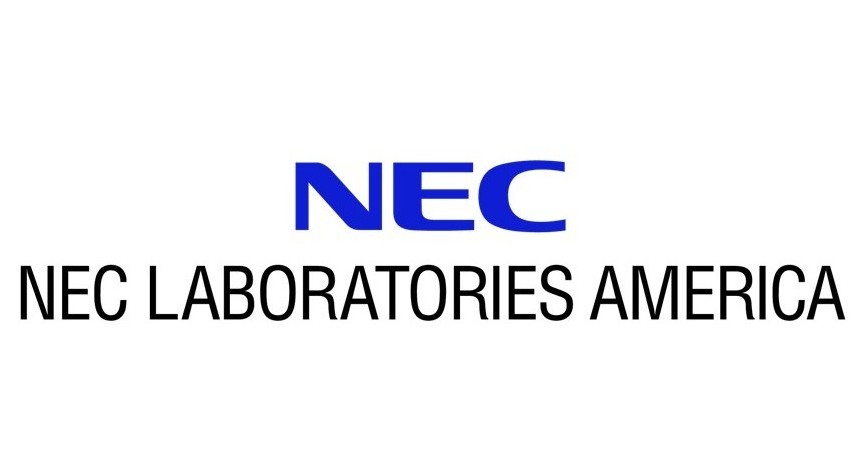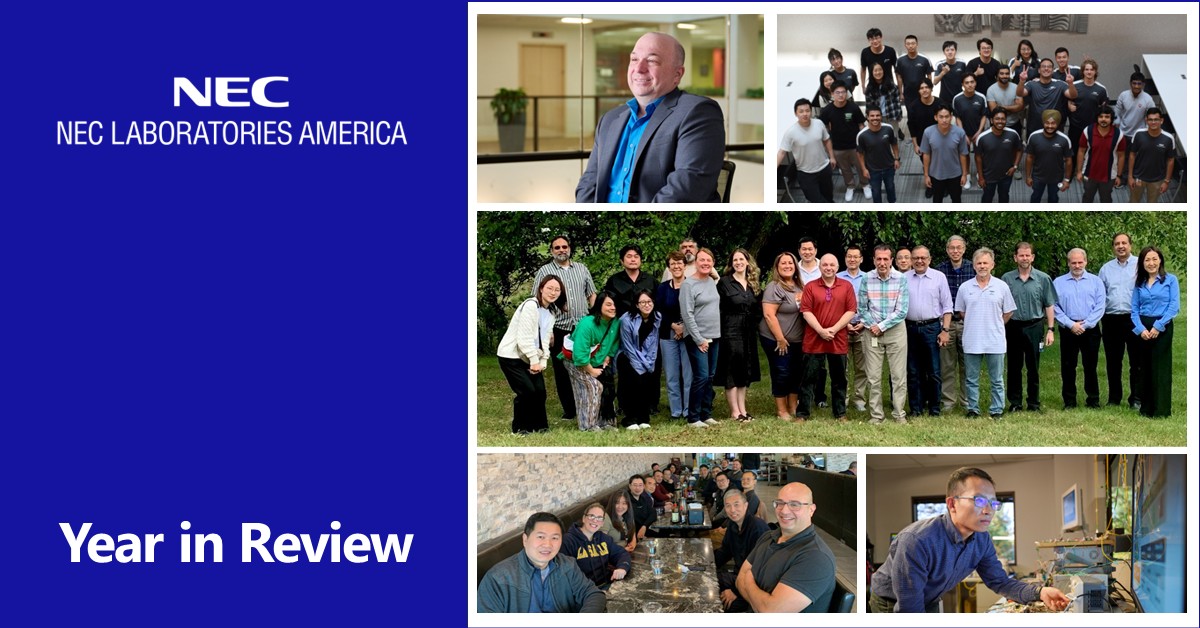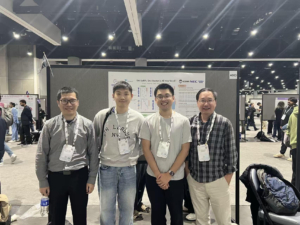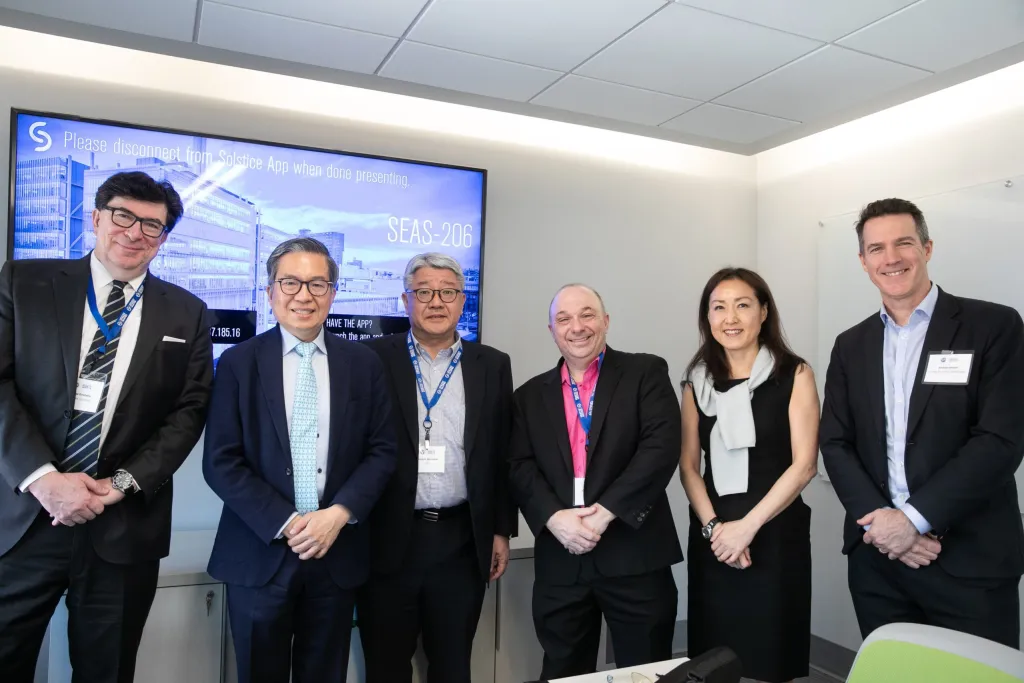NEC Laboratories America 2025: A Year of Disruptive Innovation
As 2025 comes to a close, we reflect on a year marked by scientific breakthroughs, global recognition, expanded collaborations, and a renewed commitment to research with real-world impact.
This past year, our research teams at NEC Laboratories America deepened their contributions across artificial intelligence, networking and sensing, system security, multimodal analytics, and integrated systems.
Our researchers published at the world’s most selective conferences, launched exciting collaborations with academic and industry partners, and represented NEC on stages around the globe. At the same time, we strengthened the community within our Princeton and San Jose labs, fostering a culture of curiosity, mentorship, and innovation. This wrap-up celebrates the people, ideas, and milestones that shaped 2025 and sets the stage for a promising year ahead.
Advancing Research That Makes a Difference
We entered 2025 with a bold vision: accelerate disruptive innovation across core research areas while driving solutions that address emerging industry and societal needs. Over the course of the year, our teams delivered breakthroughs in fields including edge AI, high-performance computing, optical networking, system security, multimodal reasoning, foundation models, spatial computing, and autonomous sensing.
New Patents
We expanded our extensive intellectual property portfolio with nearly 100 new U.S. patents contributed by our researchers in Data Science & System Security, Integrated Systems, Machine Learning, Media Analytics and Optical Networking & Sensing. This research has strengthened NEC’s leadership in sensing, measurement, optical networking, and AI-driven system intelligence. These patents reflect the technical excellence and inventive spirit that drive our research forward. Patents awarded in 2025 included innovations in:
- Spatially multiplexed acoustic communications
- Laser frequency stabilization and compensation
- High-precision barometric measurement systems
- Fiber-enabled gunshot detection
- Self-coherent detection for data centers
New Publications
Our researchers have published over 100 papers pushing the boundaries of AI, multimodal reasoning, photonics, and system design. We expanded the scope of what’s possible, from more reliable autonomous systems to network technologies built for tomorrow to new tools for human-machine collaboration. Through partnerships across academia and industry, and a relentless commitment to rigorous research, NECLA continued to advance its mission: to generate new knowledge and deliver innovative solutions that tackle real-world challenges. This year’s achievements demonstrate not only technical excellence but also an increasing emphasis on interpretability, safety, and practical deployment. The papers we highlight below reflect the diversity, ambition, and impact of our 2025 research across AI, perception, communications, and systems.
- xTime: Extreme Event Prediction with Hierarchical Knowledge Distillation and Expert Fusion (Data Science & System Security): A forecasting framework that improves the prediction of rare, high-impact extreme events in time series by distilling knowledge from more common precursor events and using a dynamic mixture-of-experts to boost accuracy by up to 78%.
- TalentScout: Multimodal AI-Driven Expert Finding in Organizations (Integrated Systems): An AI-driven expert identification system that builds a unified, skill-centric knowledge graph from diverse enterprise content and consistently outperforms leading baselines in expert retrieval, offering scalable, transparent, and evidence-based talent discovery.
- Quantitative Bounds for Length Generalization in Transformers (Machine Learning): Provides the first quantitative bounds on when transformers generalize to more extended sequences than those seen in training, sharpening our understanding of length generalization behavior.
- AutoScape: Geometry-Consistent Long-Horizon Scene Generation (Media Analytics): Proposes a long-horizon driving scene generation framework using an RGB-D diffusion model that creates geometrically consistent keyframes and realistic 20+ second driving videos.
- Neuromorphic Photonics-Enabled Near-Field RF Sensing with Residual Signal Recovery and Classification (Optical Networking & Sensing): Demonstrates a near-field RF sensing system that combines microwave photonic cancelation with a neuromorphic photonic recurrent neural network for high-bandwidth, low-latency signal classification.
Project Research
Several projects stood out for their blend of scientific novelty and real-world relevance from our Data Science & System Security, Integrated Systems, Machine Learning, Media Analytics and Optical Networking & Sensing departments. These innovations align with NEC’s global mission: to build technology that solves human-scale problems, from future transportation systems and smarter cities to secure networking and advanced digital infrastructure.
- AI for Space (Data Science and System Security): Our teams’ advanced numerical and categorical sensor monitoring for spacecraft, enabling more intelligent anomaly detection and enhanced operational safety.
- Multimodal Distributed Optical Sensing (Optical Networking & Sensing)
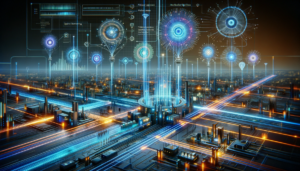 : We are developing new optoelectronic designs and FPGA-based signal-processing technologies to improve DFOS systems. Additionally, we are developing novel applications to effectively utilize fiber sensing technologies for monitoring traffic, energy, etc.
: We are developing new optoelectronic designs and FPGA-based signal-processing technologies to improve DFOS systems. Additionally, we are developing novel applications to effectively utilize fiber sensing technologies for monitoring traffic, energy, etc. - Multimodal Stream Fusion (Integrated Systems): We are leveraging machine learning techniques to bridge radically different data semantics, vastly different data characteristics and the lack of a typical frame of reference across different digital streams.
- Trustworthy Generative AI (Machine Learning): We are focused on developing advanced multimodal generative models that can create and reason with content across text, images, reports, and 3D videos. These models are designed for applications in advertising, entertainment, law enforcement, and healthcare.
- Autonomous Driving (Media Analytics): Our full-stack autonomy solutions include perception, prediction, planning, simulation and DevOps that leverage the latest advances in generative AI, neural rendering, large language models, diffusion models and transformers.
Events & Conferences: A Year of Global Visibility
One of our organization’s defining strengths is our presence at influential events and conferences worldwide. Our researchers contributed dozens of papers to elite computing and engineering venues, including NeurIPS, ICCV, ICML, AAAI, SIGCOMM, ECOC, PICom, ICASSP and INFOCOM. Below are highlights from this year’s most memorable events.
-
NeurIPS 2025 (San Diego, California): NeurIPS has become the premier AI event for breakthroughs in artificial intelligence. Our researchers presented 7 papers spanning multimodal learning, efficient computation for foundation models, and novel approaches to generative architectures. Our researchers took part in workshops on domain-specific models, physical AI, and large-scale multimodal reasoning.
- ICCV 2025 (Honolulu, Hawaii): Computer vision remains a central pillar of our research strategy, and ICCV provided an outstanding platform for our work. Our contributions helped shape this year’s conversations around robustness, generalization, and the responsible deployment of computer vision systems in real-world contexts.
- ECOC 2025 (Copenhagen, Denmark): For our Optical Networking & Sensing (ONS) team, ECOC is an annual milestone, and 2025 was no exception. ECOC remains one of the most internationally visible stages for ONS, reflecting our longstanding leadership in optical and photonics research. Our researchers presented advances in fiber sensing, optical communications, and photonic systems that push the boundaries of high-capacity and high-precision networks.
- OFC 2025 (San Diego, California): At OFC, we showcased our cutting-edge research and advancements through multiple presentations, demonstrations, and workshops. Our team participated in the Open ROADM MSA SDN Integrated Demonstrations, collaborating with industry leaders to highlight a multi-vendor, SDN-controlled optical transport network featuring dynamic wavelength circuit provisioning. This demonstration underscored the power of open software and disaggregated hardware in enhancing network interoperability and efficiency.
University Collaborations
We collaborated with major academic institutions across the U.S., Europe, and Asia. These collaborations extended across topics such as secure generative AI, autonomous systems, multi-fidelity sensor fusion, optical system design, and large-scale simulation frameworks. Joint workshops, campus visits, and shared student programs enriched both research quality and community connections. These organizations included:
- Princeton University
- Massachusetts Institute of Technology (MIT)
- Stanford University
- Carnegie Mellon University
- Columbia University
Industry Partnerships
We continued to work with partners in telecommunications, aerospace, mobility, logistics, cybersecurity, and digital infrastructure—often supporting proof-of-concept deployments of our research. These engagements help ensure that NEC’s global research ecosystem continues to produce innovations that are practical, impactful, and ahead of market needs. Notable areas of collaboration included:
- AI-supported infrastructure monitoring
- Intelligent network automation
- Categorical-and-numerical sensor anomaly detection
- Real-time perception for drone and UAV navigation
- Edge-AI optimization for IoT environments
- Secure model development for regulated industries
Internship Program Growth
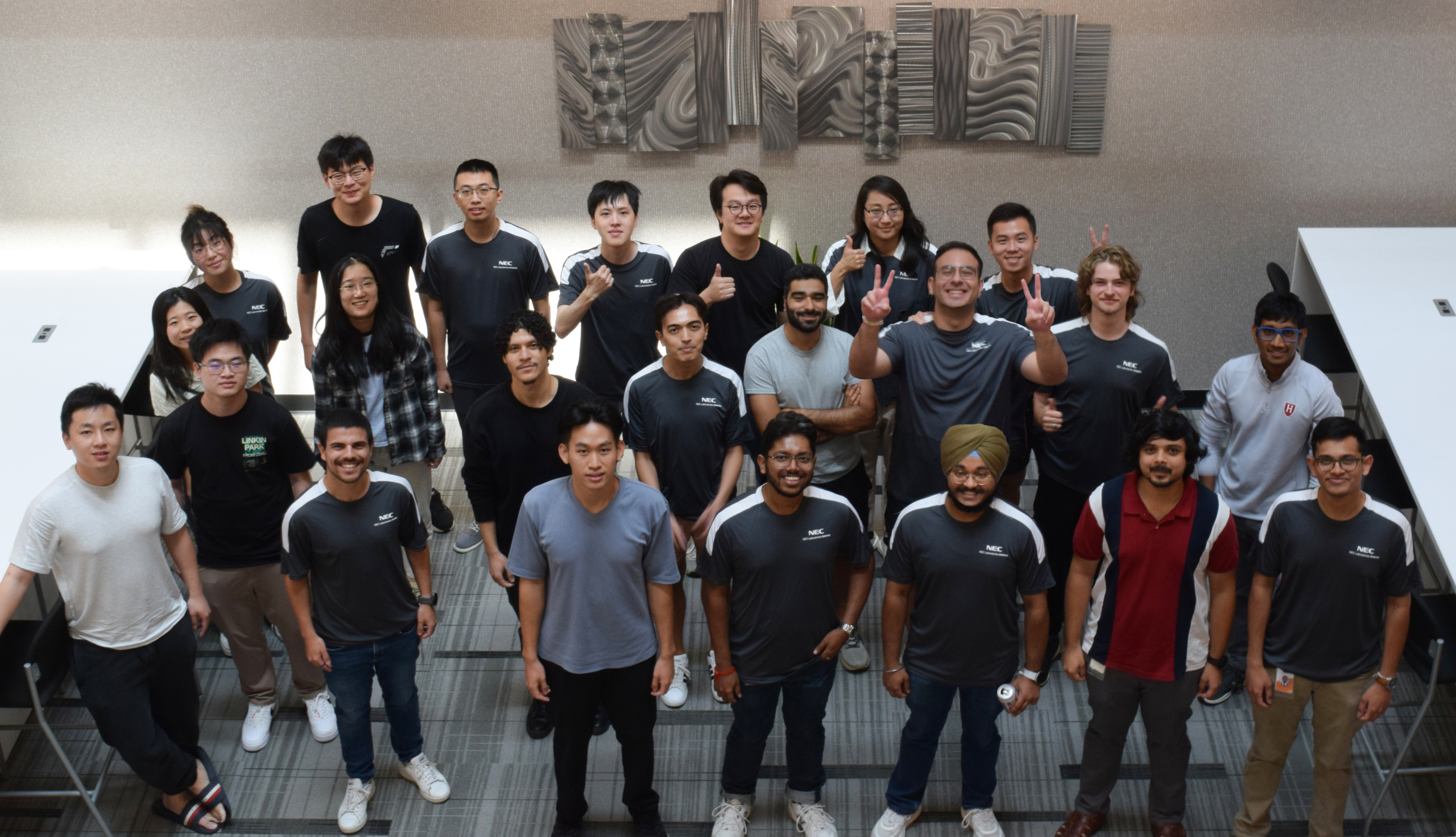 Our 2025 internship program welcomed students from top universities worldwide. Interns collaborated on projects at the forefront of AI, robotics, optical networking, cybersecurity, and multimodal systems—often contributing to published papers and prototypes. Applications for Summer 2026 opened earlier this fall, and we are already seeing strong interest. We look forward to welcoming the next cohort of brilliant young researchers in the year ahead.
Our 2025 internship program welcomed students from top universities worldwide. Interns collaborated on projects at the forefront of AI, robotics, optical networking, cybersecurity, and multimodal systems—often contributing to published papers and prototypes. Applications for Summer 2026 opened earlier this fall, and we are already seeing strong interest. We look forward to welcoming the next cohort of brilliant young researchers in the year ahead.
Celebrating Our Community: Our People, Culture, and Shared Moments
While our research defines our mission, our people define who we are. In 2025, we continued to cultivate a workplace culture of curiosity, mentorship, and connection. Across both our Princeton and San Jose locations, researchers gathered for celebrations, workshops, outings, and team-building events from kayaking outings and pho lunches to collaborative meetings and group celebrations around new patents and publications.
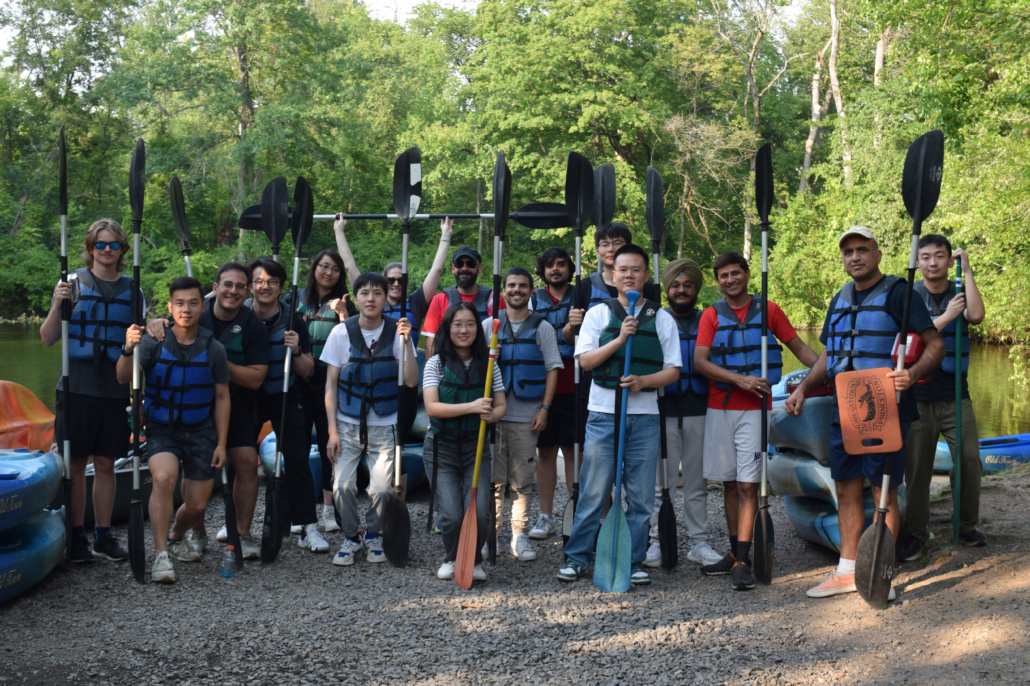 Whether participating in ECOC or presenting breakthrough fiber-sensing research, our teams brought energy and creativity to every milestone. These shared experiences strengthen the vibrant, supportive community that makes NEC Labs America a unique place to work and innovate. Across departments, our teams enjoyed:
Whether participating in ECOC or presenting breakthrough fiber-sensing research, our teams brought energy and creativity to every milestone. These shared experiences strengthen the vibrant, supportive community that makes NEC Labs America a unique place to work and innovate. Across departments, our teams enjoyed:
- Spring and fall picnics in Princeton and San Jose
- Cross-department research demos
- Conference celebration luncheons
- Volleyball and kayaking outings
- Holiday gatherings and cultural events
Looking Ahead to 2026: A Year of New Opportunities
As we prepare for 2026, we are strategically positioned to accelerate discovery in key areas, including domain-specific foundation models, AI-native development platforms, physical and embodied AI, next-generation sensing architectures, and high-performance computing. Global conversations about AI responsibility, sustainability, and societal impact are gaining momentum. Our mission is to create technologies that are powerful, trustworthy, and beneficial and that imperative has never been more essential. We enter 2026 energized, focused, and inspired, and we will continue to:
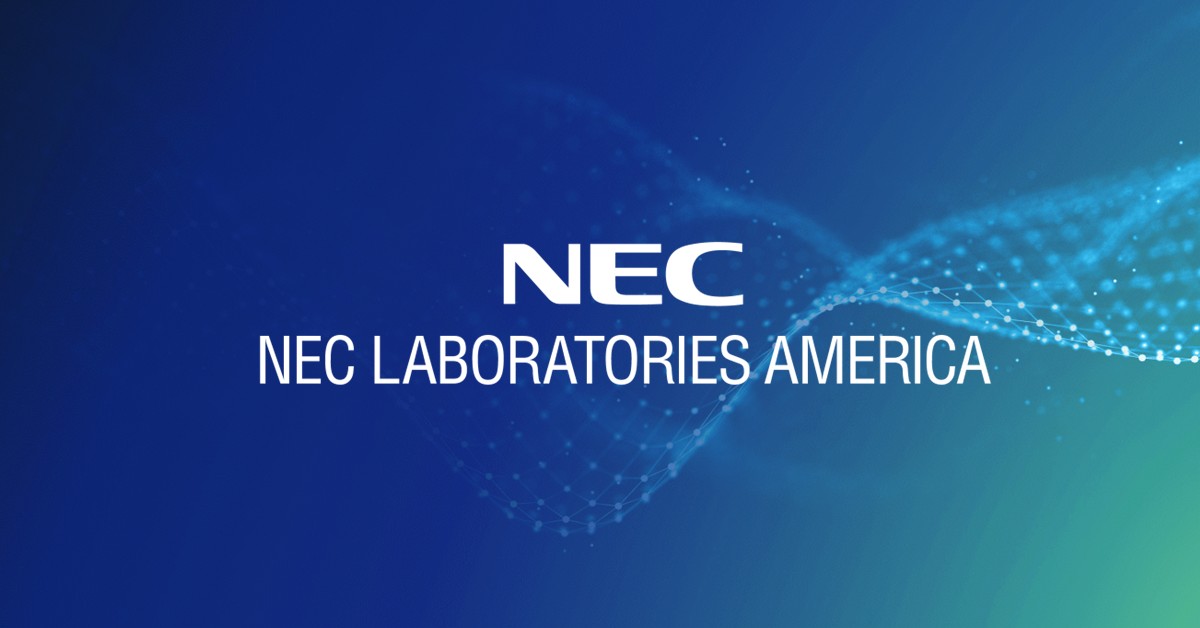 Deepen its scientific contributions across top research venues.
Deepen its scientific contributions across top research venues.- Expand global collaborations with universities and industry partners.
- Build new pathways to bring research from the lab to the world.
- Support the growth of early-career researchers and interns.
- Foster a collaborative, inclusive, and supportive community.
A Final Word of Thanks
To our researchers, staff, collaborators, and supporters, thank you for your dedication, creativity, and commitment to excellence throughout 2025. Every paper, workshop, prototype, dataset, and invention represents countless hours of deep thinking, experimentation, and team collaboration. This year’s achievements reflect not only technical brilliance but also a shared passion for advancing the frontiers of knowledge. We look forward to building on this momentum together in 2026.
From all of us at NEC Laboratories America, we wish you a wonderful holiday season and a bright, inspiring year ahead.
